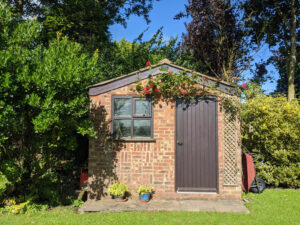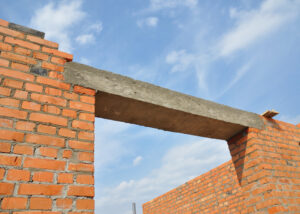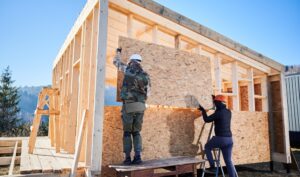Residential fencing is one of the most necessary parts of your home. Not only does it give you privacy and security but it also helps to outline the boundaries of your home.
There are so many queries when it comes to erecting a fence. Who’s responsible for which side of the fence? Are you okay to paint your neighbour’s fence? The questions are endless.
Luckily for you, we have put together a guide to fencing that covers some of the most frequently asked questions when it comes to boundary rights and installing fencing.
Do I need to erect a fence?
One of the biggest surprises from this post may be the discovery that there is no legal obligation to install fencing in your home.
However, you must always check that your home doesn’t comply with any of the following before deciding not to erect a fence.
When to legally install a fence?
- To keep livestock secure in your fields and stop them from escaping.
- If you live next to a railway line or station.
- If your deeds require you to erect a fence.
If you are thinking about not installing a fence, then you may want to think again. Installing a fence has so many major benefits. These types of advantages include security and safety in your home.
This is especially important if you have children or pets. Erecting a fence will keep your children and pets exactly where they need to be; in your garden. Having a fence in your home will also keep burglars at bay. So, always keep that in mind!
Another big reason why you should erect a fence in your home is to increase the value of your property. Installing a fence can make your home look so much more attractive. Therefore, you will significantly improve the market value of your home.
What is the best way to mark my property’s boundary?
One of the best ways to mark your property’s boundary is to erect a fence. However, there are some standards that you will need to meet. Erecting a fence needs to be done correctly to avoid any conflicts with your neighbors.
If you are unsure of your boundaries, then the best place to start is to check out your property’s deeds. The deeds of your home should have a clear image with your property’s boundaries outlined in bold.
Once you have your boundaries, you are then ready to erect your fences. A popular question that many homeowners ask is where should they position their fences. It is important to get it right as it helps to avoid any disputes with your neighbors and any additional costs.
You should place the posts of your fence on your land and face the outside of your fence panel along the boundary. Make sure that the outside of your fence is placed along your boundary and not over it. This could cause disputes.
A handy piece of information to note is that if you require footings for your fencing, then these can be partly under your neighbor’s land – Party Wall, etc. Act 1996.
Which side of the fence am I responsible for?
Again, this is a hugely popular question asked when it comes to erecting a new fence. Many people would argue that there is one side of the fence that a neighbor is always responsible for. We just want to let you know that this is not true.
To find out what side of the fence you are responsible for, it is time to dig out your deeds. The ownership of each side of the fencing is declared by the original homeowner. So, if you ever have any confusion, head straight to your deeds.
How do I tell how old my fence is?
If you didn’t install the fencing already in your home, then it could be hard to tell how old your fence is. Some people believe that tree dating could be a possible indicator of how old your wooden fence is. This is not true.
The best thing to do in this case is to take a look at your fence and decide whether it is in good condition or not. If it seems to be stable, then you probably don’t need to replace it for a few years.
If you did install your fencing on your property but don’t remember exactly when try digging out your old invoice or receipt. This should be easier to do if you got the invoice emailed directly to your inbox.
As a last resort, if your property has been passed down to you by a family member, there is a trick you could try out. Go through old family photos and try to find any with your fence in. You should be able to roughly tell when the fence was installed from these.
Are there any rules on how high my fence should be?
Another thing that you will need to consider is the height of your fence. This is especially true if you have any pets that you need to keep enclosed safely.
The rules for fence height unfortunately vary from town to city. For the most accurate answer to this, you should contact your local authority planning office. From there, you will be able to understand straight away how high you are allowed to go.
If you want to get on with the job without having to contact your local authority planning office, there is a good place to start. If you go for a 2m height there shouldn’t be any issues.
What to do if my neighbor’s fence is damaged or falling down?
This can sometimes be an awkward situation but it is more common than you may think. The first thing you should do is inform your neighbor. As the damage is on your side of the fence then they may not be aware that it requires a repair.
Some neighbors may be more or less inclined to fix their fences as quickly as others. With this being said, if your neighbor does slack at repairing their fence efficiently then your best bet is to erect fencing panels on your boundary.
Doing this will prevent any further disputes and you will be able to manage the upkeep of the fencing panels yourself as you will not be permitted to fix your neighbor’s fence without their permission.
Is it okay to paint, varnish or stain my neighbor’s fence?
If you want to paint, varnish, or stain your neighbor’s fence, you should first ask their permission. If you don’t do this, it could cause some disputes that may not be pleasant to live with.
It is important to note that if you do paint their fence without permission then it could be escalated to a criminal damage case.
Is it okay to hang planters on my neighbor’s fence?
If you are thinking about hanging planters or leaning items against your neighbour’s fence, then you must ask their permission first.
Similar to painting, if you start hanging things against your neighbour’s fence without their permission, you could begin to face arguments that you would probably want to avoid in the first place.
You may wonder why you need permission to do this and it is quite simple. If your planters cause damage to your neighbour’s fence, then you will have to pay for any repairs. This could end up costing you quite a lot of money depending on the amount of damage.
If you want to make any changes to your neighbour’s fence that is facing your garden, ask first before making any changes. If they say no, you could always erect your own fence against your boundary. That way, you can do whatever you want to the fence in question.
What types of fences are available?
There are so many different types of fences available to suit your needs. So, don’t feel like you have to settle with the most basic fence. Below we have compiled a list of some of our favourite fences that are available on the market right now.
Closeboard fencing panels
This is one of the most popular fencing choices. It is mainly down to its durable strength and attractive look. It is also easy to install and that in itself is a beneficial feature for potential buyers.
Heavy-duty close-board panels
If you live in an open area, or somewhere with high winds this is a great option for you. The panels have been designed to be extremely heavy-duty and will last you a long time throughout the years.
Waney-edge panels
Another popular fencing option is these waney-edge panels. The panels have a long-lasting design that requires little maintenance throughout the years.
Trellis panels
If you need a little extra privacy or are looking to grow some climbing plants against your fence, trellis panels are a good option for you. They can look really attractive once painted and installed correctly.
Palisade picket fence
A picket fence is one of the most attractive panels to choose from. They give off a true home feel without slacking on durability. This type of fence is super easy to install too which is always a plus.
Post and wire fencing
If you are looking for something that doesn’t include too much wood, post and wire fencing could be something to think about. It is easy to erect and will last a long time too.
Five bar gates
For drives that need extra security, a five-bar gate is a great choice. They can be made to fit your drive and will stay sturdy for a long period of time.
Post and rail fencing
Another type of fencing is a post and rail. This is made with quality material that looks very attractive once erected. You will also have no problems when trying to install this type of fencing.
Metal railings and gates
Are you interested in fencing that is not made from wood? Then look no further than metal railings and gates. These are massively durable and provide some of the best security. They also look great against many different renders.
- Drill Battery Maintenance: Essential Tips for Cordless Drill Battery Care - February 5, 2024
- Troubleshooting Drill Issues - February 5, 2024
- Quick Drilling Techniques - February 2, 2024






The information is useful but doesn’t quite answer my question, can you help further please?
The deeds depict next door would be responsible for the boundary line however we have a damaged picket fence (ours) on that line and began replacing it however mid way through our neighbour pulled up the posts and panel and tossed them on to our path stating it is his boundary line.
Is he allowed to do this? The Police have shown very little interest being reluctant to become involved in a boundary dispute although they are looking at potential ‘criminal damage’ yet dragging their feet for some three weeks now.
In the mean time, I have abandoned any further work waiting on the Police and attempting to find an answer?
We are simply wanting to replace an existing fence in exactly the same place as before!